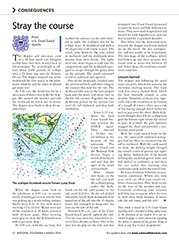Stray the course
From U.S. Coast Guard reports
The skipper and two-man crew of a 58-foot wood and fiberglass scallop boat they were headed back to Chincoteague, Va., at midnight to off-load about 2,450 pounds of scallops after a 28-hour trip into the Atlantic Ocean. The skipper assigned one of the deckhands the first watch in the pilothouse while he and the other deckhand got some rest.
At 3:30 a.m. the vessel was hit by a succession of waves that woke the skipper. He assessed the weather and told the deckhand on watch not to worry. The skipper went back to sleep for another hour.
When the skipper came back to the pilothouse at 4:30 a.m. to assume watch, it had begun to rain and the boat was picking up a steady rolling motion. Swells were 8 to 10 feet with waves reaching 12 to 15 feet. Winds were out of the southwest at 30 knots sustained with 40-knot gusts. After securing some gear on deck, the deckhands were told to get some sleep.
At 5:50 a.m. with the sea buoy that marked the entrance to the inlet channel in sight, the scalloper was hit by a huge wave. It shuddered and took a 90-degree shear off course to port. The vessel, now beam-to the seas, rolled to starboard, and the deckhands were thrown from their bunks. The lights went out; water began to rush into the compartment, and the deckhands managed to escape through the galley door on the portside. The vessel continued to roll to starboard and capsized.
One of the deckhands climbed onto the overturned hull, and other clung to the canister that held the life raft. The deckhand who was on the hull jumped back into the water and swam over to the life raft canister. Together, the two deckhands pulled on the painter line until the raft deployed, and they both climbed in.
It was 6 :10 a.m. when the local Coast Guard Station received the EPIRB signal. They directed a 44-foot motor lifeboat to the location of the activation. The Coast Guard and the National Park Service began a search of the beach and surf line for signs of the vessel and survivors.
After almost two hours in the life raft and with the scalloper going under, the deckhands cut the life raft’s painter so the raft could drift free. As the raft drifted toward the beach, both deckhands were tossed out of the raft into the 41-degree water, but managed to hang onto the lines on the side of the raft.
Around 8:30 a.m., one of the Coast Guard beach patrols sighted the raft. The two men were too exhausted to retrieve lines thrown to them. One of the men lost his grip on the raft, and that prompted two Coast Guard personnel to enter the water and help both men to shore. They were both hospitalized and treated for mild hypothermia, and one was treated for a separated shoulder.
Two hours after the deckhands were rescued, the skipper was found washed up on the beach. He was unresponsive and was unable to be resuscitated. The wreckage of the scalloper, which had broken up into three sections, was found sunk in water that between 12 and 18 feet deep; the vessel was considered a total loss.
Lessons learned
The skipper was following his usual route into port, which was stored in his electronic charting system. The track took him over a charted shoal, which the boat routinely crossed in calm weather. However, in heavy seas, especially when the vessel was at the bottom of a trough of a wave, there was a risk of not having enough water under the keel to pass over the shoal. Both deckhands thought they felt the scallop boat grab the bottom right before she turned to port. It is likely the port stabilizer snagged the shoal and provided a momentary pivot point.
With the vessel turned beam to the sea, the unsecured stabilizers/outriggers had no effect in counteracting the roll to starboard. With the catch stored on deck, the shifting weight changed the vessel’s center of gravity and righting ability. Additionally, if the barrels holding the catch had gotten loose and had shifted to starboard, as had been the case earlier that morning, that could have easily sealed the vessel’s fate.
Be wary of routine behaviors in non-routine conditions. Where you stow your catch can affect your vessel’s stability characteristics. Also, keep an eye on the state of the weather and seas. Constantly evaluating your situation will help you recognize when it’s time to shift away from business as usual, take the safe route, and fish safe!
This article is based on U.S. Coast Guard reporting and is intended to bring safety issues to the attention of our readers. It is not intended to judge or reach conclusions regarding the ability or capacity of any person, living or dead, or any boat or piece of equipment.








